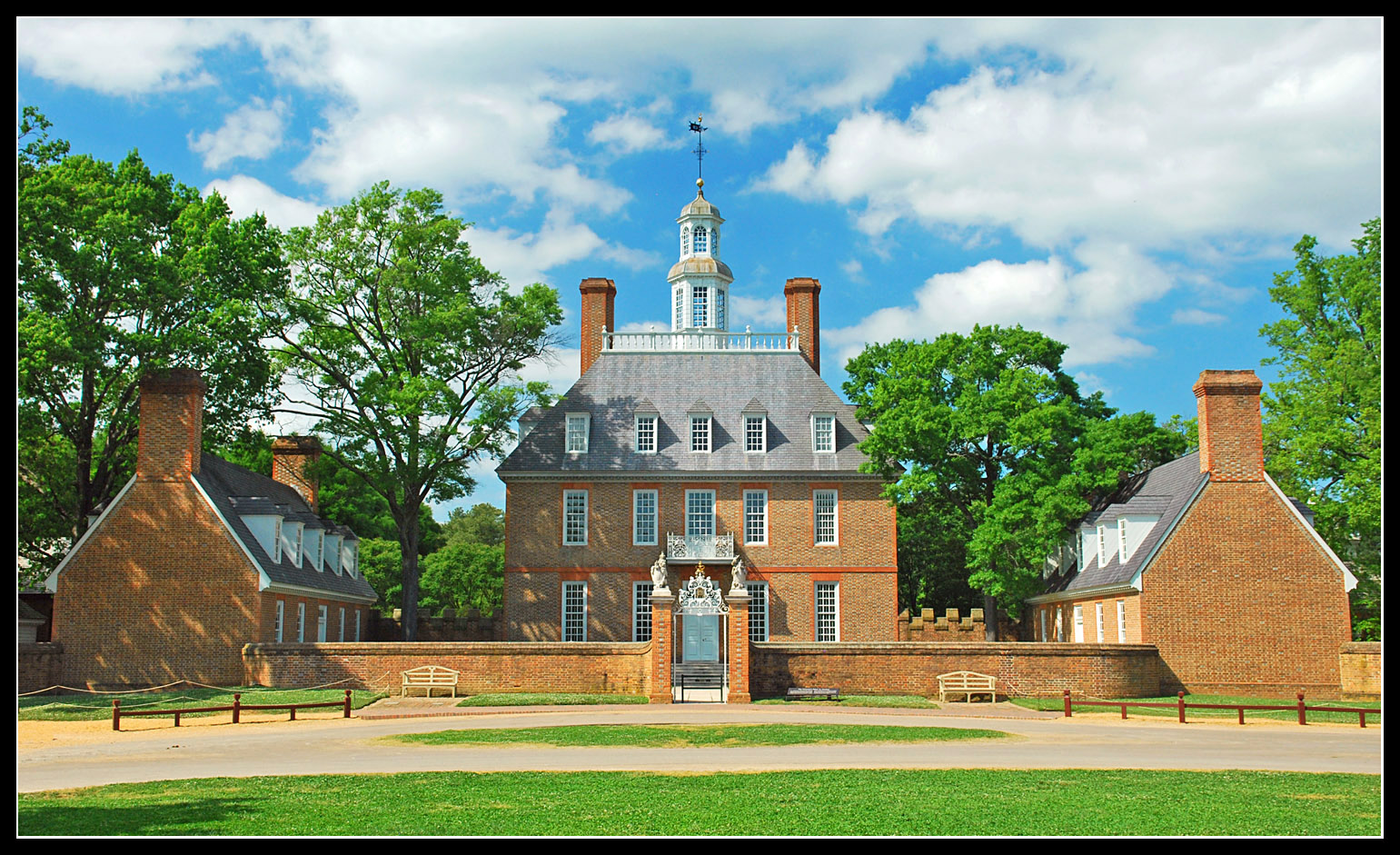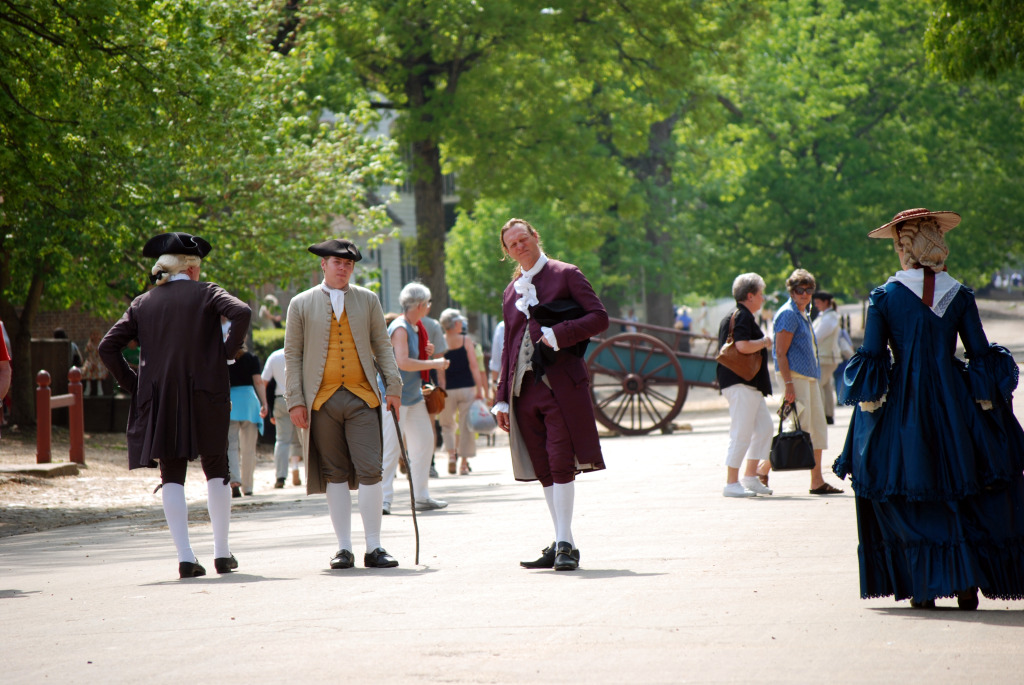by Matthew Phipps
Recently I paid a visit to Colonial Williamsburg, the former seat of state and colonial government that sits, in its current form—partially preserved, partially reconstructed, peopled by re-enactors in bulky period dress—halfway down the Virginia Peninsula, between the tidal flows of the James and York Rivers. While I had never been to Williamsburg before, many people I spoke with before my visit described summertime family road trips to Williamsburg as significant, if hazily remembered, moments of their youth. Indeed, the very mention of its name, for them, evoked the discomforts and small pleasures of a particular sort of American childhood experience: ice cream cones and the stink of the blacksmith’s forge and sibling squabbles in the backseat; spilled popcorn and the actors yelling “Huzzah!” and horse-drawn buggies moving languidly through the streets.
Most either remembered Williamsburg in this way or equated it with other ostensibly educational, vaguely patriotic destinations they were dragged to as children, frontier towns or Spanish missions out west, Revolution-era villages or French and Indian War outposts up north; places like Tombstone, or Bisbee, or Jamestown, New York.
Growing up in a swampy corner of southwest Florida mostly undeveloped until the twentieth century, history seemed, to me, to be a long way off. Never mind the Tocobaga mounds that lined the shore not far from my house, grown over with scrub oak and sinking into the sandy soil; these were so familiar to me as to be invisible. Real history was experienced, to my young mind, in the mountain ranges and lonely expanses of the far western states, or in the bustling, storied cities along the northeastern coast. My family had no money for air travel, and from our part of the peninsula it took nearly five hours in a car just to reach the state line—and then, what, you were in southern Georgia? Mobile, Alabama?
Setting aside, for now, the limitations and prejudices betrayed by my perspective on the mounds, it seems to me that even then I began to think about the differences between “real” places, where history and industry were shaped, where important men and women had walked, and the other kind of place, which wasn’t fake, or unreal, exactly, just—something else entirely. Insubstantial or transitory are not words I would have used back then, walking through the subdivisions and acres-wide parking lots, eyeing the pine forests waiting to be felled. But isn’t it true that one does feel a quality of unreality sometimes, marooned in the midst of one of these landscapes? My school friends who escaped in the summertime, returning with stories of mountain streams and cool nights and big-city museums: they were the ones experiencing the historical, the substantial, the real. Their stories matched up with the stories I heard upon announcing my plans to visit Williamsburg. And if I didn’t share those stories, if my childhood roster of experiences didn’t match up—well, where did that leave me?
*
“To track the life of a restoration is to learn a great deal about art, history, and reality.”
Those are the words of the venerable architectural critic Ada Louise Huxtable, who died last year at age 92. Huxtable, who won the first ever Pulitzer Prize for Criticism in 1970, wrote at length about the ambiguity and paradox inherent in preservation districts such as the one at Colonial Williamsburg, which was initiated in the 1920s by the Reverend Dr. W.A.R. Goodwin and his major financial backers, John D. Rockefeller, Jr. and his wife, Abby Aldrich Rockefeller. In the first chapter of her book-length treatise The Unreal America: Architecture and Illusion Huxtable outlines a central component of her critique of the restoration movement:
“Restoration is a difficult and unclear procedure at best; unreality is built into the process, which requires a highly subjective kind of cosmetic surgery that balances life and death. At Williamsburg, there was instant amputation with the conceit of a ‘cutoff date’ for the restoration—in this case, 1770, an arbitrary determination of when, and for what purpose, a place should be frozen in time….This usually means moving or destroying a good deal of subsequent architectural history—exactly the stuff of which real history and art are made.”
Other critics have pointed to a whitewashed, sterile quality to Williamsburg’s preservation projects, and the non-profit organization that manages Colonial Williamsburg itself acknowledges, on its website, that “Colonial Williamsburg bears the burden of criticism that the restored town appears too neat and clean, too ‘spick-and-span,’ and too manicured to be believable.”

Photo by Steve Brown, Flickr user sjb4photos
I can report that most of the structures in the “restored” town are in pristine condition, sitting proudly in well-maintained environs bounded by crisp white fences or sturdy stone walls. It should be noted that most roads in the town are paved for accessibility, and modern water fountains and trash bins are tastefully concealed within rustic-seeming wooden enclosures. The Governor’s Palace, perhaps Williamsburg’s most impressive edifice, holds splendid court at the end of the Palace Green, looking for all the world as though it has been there since the beginnings of the colony—except for the fact that it was rebuilt in the 1930s, with the first influx of Rockefeller money to the project, as the main building was destroyed by fire in the 1780s and many of the remaining brick outbuildings were dismantled for building materials during the Civil War.
The reconstructed Capitol, which may be the second most imposing structure in Colonial Williamsburg, has an even more complicated history. Huxtable writes that the decision to rebuild the Capitol, which burned in 1832, spurred “architectural hairsplitting about whether to reproduce the first or second version of the building, neither of which had been there for quite some time.” What is more, she continues,
“The rebuilders of the reconstructed Capitol have now been accused of redesigning it….Taught to think in terms of the formal classical symmetry of their Beaux Arts training, the reconstruction architects could not believe, or accept, that the building’s axis could have been off-center. The entrance contradicts the evidence of the foundation and is probably in the wrong place. Other spatial relationships are also questionable.”
What interests me most in The Unreal America is Huxtable’s impassioned explanation of what troubles her personally about places like Williamsburg:
“What the perfect fake or impeccable restoration lacks are the hallmarks of time and place. They deny imperfections, alterations, and accommodations; they wipe out all the incidents of life and change. The worn stone, the chafed corner, the threshold low and uneven from many feet, the marks on walls and windows that carry the presence and message of remembered hands and eyes….are absent or erased. There is nothing left of the journey from there to here, nothing that palpably joins the past to the present, that makes direct physical and emotional contact with the viewer, the bittersweet link with those who have been there before.”
Huxtable’s notion of “the journey from there to here,” with its implicit ideas of movement and change, along with the notches, scuffs and patches that change necessitates, begins to explain the strange sense of “unreality” one feels in places like Williamsburg or Tombstone, and seems, to me, to get to the heart of a certain kind of truth.
In my capacity as an editor of Broad Street, I am constantly reading submissions, on the lookout for more “true stories” to present in upcoming issues. It strikes me that Huxtable’s ideas about truth and reality apply not just to historical artifacts and locales, but to stories themselves, which purport to take us to a sort of place in time. Most successful stories may do a solid job evoking a specific setting or scene, or even a compelling portrait of an unusual character, but the best of these also convey “all the incidents of life and change,” the feeling of time passing, which is the only eternal truth we know.
Transcending both local and cultural narratives, this capacity for and openness to change is what grounds us in reality and keeps us moving forward, for better or worse; it makes dynamic characters of the people in our lives. It leads me to believe I might reconsider the significance and vitality of the places of my youth, those desecrated mounds and vulnerable pines. I may well find a good story there somewhere.









